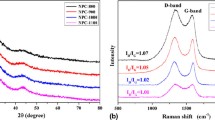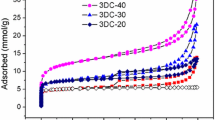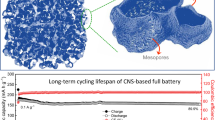Abstract
Lithium metal is regarded as the most potential anode material for its high specific capacity, but lithium dendrite growth and volume expansion problems limit its application. Herein, a simple vacuum filtration process is used to synthesize a porous network composed of carbon nanotubes (CNTs) and carbon nanocoils (CNCs) as the 3D lithium metal host. The high specific surface area and the good lithiophilicity of CNC@CNT structure promote the uniform lithium deposition and inhibit the formation of lithium dendrites. The introduction of super-elastic CNCs effectively prevents the agglomeration of CNTs, and provides fast transport paths and abundant space for lithium ions. Meanwhile, it releases partial stress during cycling. The electrode presents a low overpotential of 11.8 mV at 0.5 mA cm−2, and the average coulombic efficiency is 97.3% under nearly 200 long-time cycles, which provides a good idea for the improvement of 3D host for lithium metal anode.
Graphical abstract







Similar content being viewed by others
Data availability
The data that support the findings of this study are available from the corresponding authors upon request.
References
J.I. Lee et al., Lithium metal interface modification for high-energy batteries: approaches and characterization. Batter. Supercaps 3(9), 828–859 (2020)
J.M. Tarascon, M. Armand, Issues and challenges facing rechargeable lithium batteries. Nature 414, 359 (2001)
Y. Lu, Q. Zhang, J. Chen, Recent progress on lithium-ion batteries with high electrochemical performance. Sci. China Chem. 62(5), 533–548 (2019)
J.B. Goodenough, K.S. Park, The Li-ion rechargeable battery: a perspective. J. Am. Chem. Soc. 135(4), 1167–1176 (2013)
D. Lin, Y. Liu, Y. Cui, Reviving the lithium metal anode for high-energy batteries. Nat. Nanotechnol. 12(3), 194–206 (2017)
J. Duan et al., Is graphite lithiophobic or lithiophilic? Natl. Sci. Rev. 7(7), 1208–1217 (2020)
S. Xin et al., Progress of rechargeable lithium metal batteries based on conversion reactions. Natl. Sci. Rev. 4(1), 54–70 (2017)
L. Grande et al., The lithium/air battery: still an emerging system or a practical reality? Adv. Mater. 27(5), 784–800 (2015)
A. Manthiram, S.H. Chung, C. Zu, Lithium-sulfur batteries: progress and prospects. Adv. Mater. 27(12), 1980–2006 (2015)
Y. Chen et al., Boosting the electrochemical performance of 3D composite lithium metal anodes through synergistic structure and interface engineering. Energy Storage Mater. 26, 56–64 (2020)
X. Ke et al., Hierarchically bicontinuous porous copper as advanced 3D skeleton for stable lithium storage. ACS Appl. Mater. Interfaces 10(16), 13552–13561 (2018)
X.B. Cheng et al., Toward safe lithium metal anode in rechargeable batteries: a review. Chem. Rev. 117(15), 10403–10473 (2017)
G. Huang et al., Lithiophilic 3D nanoporous nitrogen-doped graphene for dendrite-free and ultrahigh-rate lithium-metal anodes. Adv. Mater. 31(2), e1805334 (2019)
X.B. Cheng et al., Dendrite-free lithium deposition induced by uniformly distributed lithium ions for efficient lithium metal batteries. Adv. Mater. 28(15), 2888–2895 (2016)
H. Wu et al., In situ formation of stable interfacial coating for high performance lithium metal anodes. Chem. Mater. 29(8), 3572–3579 (2017)
J. Zheng et al., Electrolyte additive enabled fast charging and stable cycling lithium metal batteries. Nat. Energy 2(3), 1–8 (2017)
L. Suo et al., A new class of solvent-in-Salt electrolyte for high-energy rechargeable metallic lithium batteries. Nat. Commun. 4, 1481 (2013)
X. Fan et al., Non-flammable electrolyte enables Li-metal batteries with aggressive cathode chemistries. Nat. Nanotechnol. 13(8), 715–722 (2018)
N.W. Li et al., An artificial solid electrolyte interphase layer for stable lithium metal anodes. Adv. Mater. 28(9), 1853–1858 (2016)
Y. Liu et al., An artificial solid electrolyte interphase with high Li-ion conductivity, mechanical strength, and flexibility for stable lithium metal anodes. Adv. Mater. 29(10), 1605531 (2017)
X. Han et al., Negating interfacial impedance in garnet-based solid-state Li metal batteries. Nat. Mater. 16(5), 572–579 (2017)
J. Zhang et al., Safety-reinforced poly(propylene carbonate)-based all-solid-state polymer electrolyte for ambient-temperature solid polymer lithium batteries. Adv. Energy Mater. 5(24), 1501082 (2015)
H. Wang et al., Wrinkled graphene cages as hosts for high-capacity Li metal anodes shown by cryogenic electron microscopy. Nano Lett. 19(2), 1326–1335 (2019)
Y. Zhang et al., Towards better Li metal anodes: challenges and strategies. Mater. Today 33, 56–74 (2020)
C.P. Yang et al., Accommodating lithium into 3D current collectors with a submicron skeleton towards long-life lithium metal anodes. Nat. Commun. 6, 8058 (2015)
Q. Yun et al., Chemical dealloying derived 3D porous current collector for Li metal anodes. Adv. Mater. 28(32), 6932–6939 (2016)
S.H. Wang et al., Stable Li metal anodes via regulating lithium plating/stripping in vertically aligned microchannels. Adv. Mater. 29(40), 1703729 (2017)
S. Matsuda et al., Lithium-metal deposition/dissolution within internal space of CNT 3D matrix results in prolonged cycle of lithium-metal negative electrode. Carbon 119, 119–123 (2017)
Y.-J. Zhang et al., Integrated reduced graphene oxide multilayer/Li composite anode for rechargeable lithium metal batteries. RSC Adv. 6(14), 11657–11664 (2016)
J. Wang et al., Self-standing carbon nanotube aerogels with amorphous carbon coating as stable host for lithium anodes. Carbon 177, 181–188 (2021)
T. Yang et al., From flower-like to spherical deposition: a GCNT aerogel scaffold for fast-charging lithium metal batteries. Adv. Energy Mater. 11(42), 2102454 (2021)
T. Yang et al., A soft lithiophilic graphene aerogel for stable lithium metal anode. Adv. Funct. Mater. 30(30), 2002013 (2020)
W. Yao et al., General synthesis of uniform three-dimensional metal oxides/reduced graphene oxide aerogels by a nucleation-inducing growth strategy for high-performance lithium storage. ACS Sustain. Chem. Eng. 7(1), 847–857 (2018)
J. Zhou et al., Lithium-metal host anodes with top-to-bottom lithiophilic gradients for prolonged cycling of rechargeable lithium batteries. J. Power Sour. 495, 229773 (2021)
J. Yang et al., Multi-dimensional hybrid flexible films promote uniform lithium deposition and mitigate volume change as lithium metal anodes. J. Energy Chem. 65, 583–591 (2022)
C. Sun et al., Favorable lithium deposition behaviors on flexible carbon microtube skeleton enable a high-performance lithium metal anode. J. Mater. Chem. A 6(39), 19159–19166 (2018)
L. Liu et al., Free-standing hollow carbon fibers as high-capacity containers for stable lithium metal anodes. Joule 1(3), 563–575 (2017)
X.X. Ma et al., The defect chemistry of carbon frameworks for regulating the lithium nucleation and growth behaviors in lithium metal anodes. Small 17, e2007142 (2021)
B. Feng et al., Fabrication of mesoporous metal oxide coated-nanocarbon hybrid materials via a polyol-mediated self-assembly process. Nanoscale 6(23), 14371–14379 (2014)
R. Zhang et al., Lithiophilic sites in doped graphene guide uniform lithium nucleation for dendrite-free lithium metal anodes. Angew. Chem. Int. Ed. Engl. 56(27), 7764–7768 (2017)
A. Pei et al., Nanoscale nucleation and growth of electrodeposited lithium metal. Nano Lett 17(2), 1132–1139 (2017)
K. Liu et al., Oxygen-rich carbon nanotube networks for enhanced lithium metal anode. Energy Storage Mater. 15, 308–314 (2018)
X. Chen et al., Lithiophilicity chemistry of heteroatom-doped carbon to guide uniform lithium nucleation in lithium metal anodes. Sci. Adv. 5, 7728 (2019)
Y. Liu et al., A scalable slurry process to fabricate a 3D lithiophilic and conductive framework for a high performance lithium metal anode. J. Mater. Chem. A 7(21), 13225–13233 (2019)
D.H. Kim et al., Porosity controlled carbon-based 3D anode for lithium metal batteries by a slurry based process. Chem. Commun. (Camb) 56(85), 13040–13043 (2020)
G. Zheng et al., Interconnected hollow carbon nanospheres for stable lithium metal anodes. Nat. Nanotechnol. 9(8), 618–623 (2014)
Y. Zhao et al., Growth of carbon nanocoils by porous alpha-Fe2O3/SnO2 catalyst and its buckypaper for high efficient adsorption. Nanomicro Lett. 12(1), 23 (2020)
Acknowledgments
This work was financially supported by the National Natural Science Foundation of China [Grant Numbers 51972039, 51803018, and 51661145025]; LiaoNing Revitalization Talents Program [Grant Number XLYC1902122]; and the Fundamental Research Funds for the Central Universities [Grant Number DUT21JC06].
Author information
Authors and Affiliations
Corresponding authors
Supplementary Information
Below is the link to the electronic supplementary material.
Rights and permissions
About this article
Cite this article
Zhao, H., Chen, H., Wang, C. et al. Three-dimensional porous framework constructed by hybrid of carbon nanotubes and carbon nanocoils for stable lithium metal anode. Journal of Materials Research 37, 2073–2081 (2022). https://doi.org/10.1557/s43578-022-00619-w
Received:
Accepted:
Published:
Issue Date:
DOI: https://doi.org/10.1557/s43578-022-00619-w




